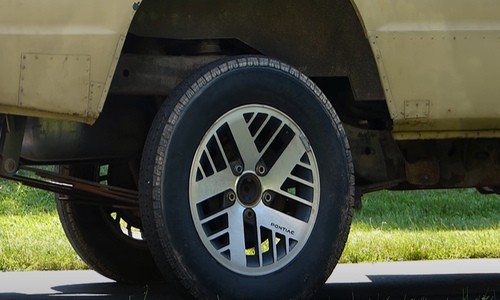Is it really necessary to rotate your car's tires?
You may have been billed severally for getting your tires rotated during your periodic maintenance, but is it really necessary to rotate your car’s tires? This action is important to help your tires last longer and not wear on time.
There is also more to rotating your car tires and this article explains it all. We also explain the signs that indicate when to rotate your tires, what happens when you don’t rotate them in due time, and how to properly do this yourself.
Is it really necessary to rotate your car’s tires?
The primary aim of rotating car tires is to help them have equal or even wear, this way they all last longer together. The thread pattern on tires provides traction and their depth decreases with time as they begin to wear out, the threads wearing out will lead to unintentional skidding and temporary or occasional loss of control while driving.
Each set of tires in the front and rear of your car has its ratio of work it has to do, at some point, the front tires do a lot more work than the rear and vice versa. Rotating the tires will help even the wear caused by this inequality.
When to rotate your tires: Signs to watch out for
Rotating your tires is usually done after you drive 5,000 miles which should be around when you go to get your oil changed. However, if you haven’t been getting these periodic tire rotations, your car will act up and these unusual behaviors will be your indications.
Poor traction
One of the uses of the threads on your tires is to provide enough traction on different kinds of surfaces and with the threads completely worn out and invisible, your tires begin to lose proper grip on the road surface. This can lead to occasional loss of control while driving and can be dangerous if not fixed immediately.

Vibration while driving
Vibration while driving has always been a big sign of tire complications and it is one you will notice if the threads on your tires are wearing out unevenly. You may detect the vibrations while driving at high or low speed and it can be seen the most on your steering wheel.
When you notice this unusual behavior, visit an auto shop to get your tires checked, rotated, or completely changed.
Uneven threads
If you inspect the tires on your cars and notice that some have deeper grooves than others, these tires have uneven threads. You can simply tell this by running your fingers on the surface of the tires, some may have more bumps or grooves while others may seem bald due to wear.
Poor fuel efficiency
We have already established that not rotating your tires can lead to uneven wear of your tires. At this state, some tires undergo too much strain to move with friction present and this requires a lot of power, thus making your car use more fuel than usual. This problem can increase your fuel mileage by 3% which is a significant amount of fuel for people who drive a lot.
What happens when you don’t rotate your tires?
Overheating
When tires move on surfaces, there is a frictional force between the surface and the tires and this force generates heat. With the threads on the tires, this heat is cooled off because the threads serve as a path for cool air to move through the tires. With these threads worn out, there is no coolant to reduce the heat and this can lead to a heated build-up.
Heat build can lead to unexpected tire failure which is a potential safety hazard and can put you at risk of an accident.
Hydroplaning
Hydroplaning happens when your car tires are temporarily separated from the road by a layer of water forced below the tires. When this happens, you completely lose traction and control over your steering and brakes.
Tires have groves or threads that help them channel water when it gets too much, however, it loses this capability when the threads are worn out. This situation can get intense and scary with just the slightest amount of water on the road, and with the presence of oil deposits on the road, you are put in a slippery condition that causes skidding and makes it unsafe to be on the road.
Punctures and blowout
Not rotating your car tires makes one of them wear thin because it experiences more strain than the others. When a tire wears thin, it becomes susceptible to punctures by objects like rocks, glass, nails, and other metals lying around. This becomes dangerous when it happens while driving.
Reduced car performance
Uneven wear in tires puts your car under a lot of pressure and requires it to use a lot of power to keep the car moving at its most optimal state. This takes a toll on the car and reduces its performance. If your tires are not changed, this problem may escalate and may lead to dangerous and scary events.
Suspension damage
The suspension system is responsible for stability while driving and ensuring that the car moves even with the presence of friction. With uneven tire wear, the suspension system takes on a lot of work that has the potential to damage it. Having a car moving with a malfunctioning suspension is risky as your car veers in one direction and you experience difficulty steering.
Warranty violation
Rotating your tires is crucial for safe driving and ensuring that no one is harmed on the road. Not rotating your tires can lead to a violation of your warranty because some manufacturers require you to carry out this action to keep your warranty valid. Information about rotating your tires may be gained by records of your trips to auto shops and this evidence is visible on your receipt.
How to rotate your car tires?
Before rotating your tires, you need to understand how the position of your car’s driving system and forces affect the wear of your tires. The braking, steering, and driving forces may be positioned in the front wheel or rear wheel axle. For a front wheel drive more strain is put on the front tires while a rear driver receives more strain on its rear tires.
The section below covers how to rotate the tires for front-wheel drive, rear-wheel drive, and 4-wheel drive.
Front-wheel drive
Since the front tires of a front-wheel drive take more strain than the rear wheel, you will need to switch them for the rotation process. This can be achieved in two ways, by switching to an x-pattern or a forward cross pattern as shown in the illustration below.
The forward cross method involves switching the front tire on the left side of the car with the rear tire on the left side of the car and doing the same with the right side of the car. The x-cross pattern involves switching the front tire on the left side of the car with the rear tire on the right side of the car and vice versa.
Rear wheel drive
For cars with this build, the rear tires do more work than the front ones, so you need to switch them for rotation. The patterns involved in this rotation are the rear cross pattern and the x-cross pattern.
Using the rear cross pattern, you will switch the rear tire on the right side of your car with the front tire on the right side of your car and do the same with the left side of your car. The x-cross pattern involves switching the rear tire on the right side of your car with the front tire on the left side of your car and vice versa.
All-wheel or 4-wheel drive
An all-wheel drive can send power to both the front and rear tires. It does this by determining which set of these wheels needs more power and traction. It follows a front-wheel drive or rear-wheel drive pattern until the idle wheel needs more traction, but most all-wheel drive has its power at its front tires. To rotate these tires, follow the forward cross method
Conclusion
If you’ve paid close attention to your receipt when getting an oil change from an auto shop you must have noticed the charge for rotating your tires, and you may have wondered “is it really necessary to rotate your car’s tires?” For the safety and optimal performance of your car, you should rotate your car tires every 5000 miles.
After reading this article, you must have learned that when your car loose traction, develops high fuel mileage, or have bald tires it indicates the need to rotate your tires. We covered the dangers of not rotating your tires and these drawbacks should give you every reason to start a periodic tire rotation.


.jpg)
